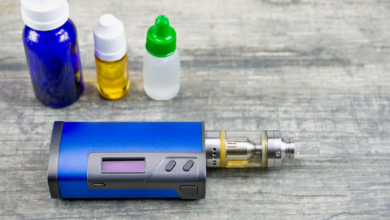Side effects of vaping

Vaping – it’s the latest trend that has taken the world by storm. Whether you’re looking to kick your smoking habit or simply enjoy the flavors and convenience, vaping has become a popular choice for many. But with all trends, there are always two sides of the coin. In this blog post, we’ll delve into the side effects of vaping that you need to be aware of. From physical discomforts to mental health concerns and long-term risks, we’ve got you covered! So grab your e-cigarette and get ready for an eye-opening exploration of what lies beyond those enticing vape clouds. It’s time to separate fact from fiction and discover the true impact that vaping can have on your well-being. Let’s dive in!
Understanding the Side Effects of Vaping
Vaping has become immensely popular in recent years, with many people turning to e-cigarettes as an alternative to traditional smoking. While it may seem like a safer option, it’s important to understand that vaping is not without its own set of side effects.
Physical Side Effects:
One of the most commonly reported physical side effects of vaping is dry mouth and throat irritation. This can be attributed to the ingredients used in e-liquids, such as propylene glycol and vegetable glycerin. These substances can cause dehydration and discomfort for some users.
Additionally, vaping has been associated with respiratory issues such as coughing, wheezing, and shortness of breath. The inhalation of chemicals found in e-cigarette aerosols can irritate the lungs and airways over time.
Mental Health Effects:
While more research is needed in this area, there have been reports suggesting a link between vaping and mental health issues. Some individuals have experienced increased anxiety or mood swings when using e-cigarettes regularly. Nicotine addiction can also contribute to these symptoms.
Long-Term Health Risks:
Although still being studied extensively, there are concerns about potential long-term health risks associated with vaping. Some studies suggest that frequent use of e-cigarettes could lead to lung damage or even the development of chronic respiratory conditions.
Secondhand Vape Exposure:
Another factor worth considering is secondhand vape exposure. Just like secondhand smoke from cigarettes, inhaling secondhand vapor from e-cigarettes may pose health risks for those around vapers, especially children and individuals with preexisting respiratory conditions.
Tips for Safer Vaping:
If you choose to vape despite the potential side effects mentioned above, there are steps you can take to minimize your risk:
1) Choose reputable brands that prioritize safety standards.
2) Avoid using homemade or unregulated products.
3) Stay hydrated by drinking plenty of water while vaping.
4) Monitor your vaping habits and take breaks if necessary.
5) Consider gradually reducing nicotine levels
Physical Side Effects of Vaping
Vaping has gained immense popularity in recent years, with many individuals turning to e-cigarettes as a perceived safer alternative to traditional smoking. However, it’s important to acknowledge that vaping is not without its own set of potential side effects. While research on the long-term effects of vaping is still ongoing, there are several physical side effects that have been reported by users.
One common concern associated with vaping is respiratory issues. The inhalation of vaporized chemicals and substances can irritate the lungs and airways, leading to symptoms such as coughing, wheezing, shortness of breath, and even lung damage in some cases.
Another physical side effect often experienced by vapers is dry mouth or “cottonmouth.” This occurs due to the dehydration caused by propylene glycol (PG) and vegetable glycerin (VG), two main ingredients found in e-liquids. These substances can absorb moisture from the mouth and throat, resulting in a dry sensation.
In addition to respiratory problems and dry mouth, some individuals may also develop skin issues as a result of vaping. Certain chemicals present in e-liquids can cause allergic reactions or irritation when they come into contact with the skin. This can lead to rashes, hives, itchiness, or redness.
Furthermore, nicotine addiction remains an undeniable concern among vapers. Nicotine is highly addictive and acts as both a stimulant and sedative on the body. Regular use of nicotine-containing e-cigarettes can lead to increased tolerance levels and dependence on this substance.
Lastly but importantly,, there have been reports linking vaping to cardiovascular problems such as an increased heart rate or blood pressure fluctuations.. While more research is needed., these findings suggest that there could be potential risks for those predisposed towards heart conditions..
It’s crucial for individuals who vape regularly or are considering taking up vaping.to be aware.of these possible physical side effects Having knowledge of the potential risks can help users make informed decisions about their health and well-being
Mental Health Effects of Vaping
Vaping has become a widespread trend, especially among young adults and teenagers. While it may seem harmless at first glance, there are potential mental health effects associated with vaping that should not be ignored.
One of the main concerns is the impact on anxiety levels. Nicotine, which is present in many vape liquids, can lead to increased feelings of anxiety and stress. This can be particularly problematic for individuals who already struggle with these conditions.
Moreover, vaping has been linked to an increased risk of depression. The addictive nature of nicotine can disrupt brain chemistry and contribute to mood disorders. Additionally, the social aspect surrounding vaping can negatively affect mental health as well.
Another important factor to consider is the influence on impulse control and addiction pathways in the brain. Vaping activates reward centers in a similar way as other addictive substances do, making it difficult for individuals to quit or cut back on their usage.
Furthermore, there have been reports linking vaping to irritability and aggression. It’s believed that nicotine withdrawal symptoms play a role in these behavioral changes.
While more research is needed to fully understand the extent of the mental health effects related to vaping, it’s clear that there are potential risks involved. It’s crucial for individuals considering or currently engaging in vaping to be aware of these possible consequences and seek support if needed
Long-Term Health Risks Associated with Vaping
When it comes to vaping, there has been ongoing debate about its long-term health effects. While it is true that vaping is often marketed as a safer alternative to smoking traditional cigarettes, the truth is that the long-term risks are still largely unknown.
One of the main concerns with vaping is its potential impact on lung health. Studies have shown that e-cigarette vapor can contain harmful chemicals and toxins, which may contribute to respiratory issues over time. In fact, some researchers have found links between vaping and an increased risk of developing chronic obstructive pulmonary disease (COPD) or other lung conditions.
Another area of concern is cardiovascular health. Although more research is needed in this area, preliminary studies suggest that vaping could potentially increase the risk of heart problems such as hypertension and arterial stiffness.
Furthermore, there are worries about the effects of vaping on oral health. The ingredients in e-liquids can cause dry mouth and irritation in the throat and mouth tissues. This may lead to gum diseases or dental issues if proper oral hygiene isn’t maintained.
Additionally, nicotine addiction remains a significant worry when it comes to long-term use of e-cigarettes. Nicotine dependence can lead to withdrawal symptoms if one tries quitting vape devices abruptly. It’s important for vapers to be aware of their nicotine intake and consider gradually reducing their levels or seeking support for cessation.
It’s worth mentioning that since e-cigarettes are relatively new products on the market, we don’t yet fully understand all possible long-term consequences associated with regular use. Therefore, it’s crucial for individuals who choose to vape to stay informed about emerging research findings regarding any potential risks they might face down the road.
In conclusion,
While many people turn to vaping as a perceived safer alternative or a method for smoking cessation, it’s essential not to overlook the potential risks involved in long-term usage. As more studies are conducted on these topics mentioned above, we will gain a better understanding of the true impact vaping has on our
Secondhand Vape Exposure
When it comes to the side effects of vaping, we often focus on the impact it has on individuals who actively engage in this habit. However, what about those who are simply bystanders? Secondhand vape exposure is an important aspect to consider.
Just like secondhand smoke from traditional cigarettes, being around someone who is vaping can expose you to potentially harmful chemicals. Although the concentration may be lower compared to direct inhalation, it doesn’t mean that there are no risks involved.
Studies have shown that secondhand vape exposure can lead to respiratory issues such as coughing, wheezing, and shortness of breath. This is particularly concerning for individuals with pre-existing conditions like asthma or chronic obstructive pulmonary disease (COPD).
Additionally, the particles released by e-cigarettes can contain toxic substances such as heavy metals and volatile organic compounds. These pollutants have been linked to adverse health effects including cardiovascular problems and lung damage.
Furthermore, children exposed to secondhand vape may be at a higher risk due to their developing respiratory systems. It’s crucial for parents or caregivers not only to refrain from vaping around children but also educate them about the potential dangers associated with these devices.
To minimize secondhand vape exposure, it’s advisable for vapers to use designated smoking areas outdoors rather than subjecting others nearby involuntarily. Additionally, increasing public awareness about this issue will help promote healthier environments for everyone.
Tips for Safer Vaping
When it comes to vaping, safety should always be a top priority. Whether you’re a beginner or an experienced vaper, it’s important to take steps to minimize potential risks and ensure a safer vaping experience. Here are some tips to help you vape responsibly.
1. Choose reputable brands: Look for well-known and trusted brands that prioritize quality and safety in their products. Avoid purchasing cheap or counterfeit vaping devices as they may not meet the necessary standards.
2. Read product labels: Take the time to read the labels on e-liquids and understand what ingredients they contain. Avoid products that have unclear or incomplete labeling.
3. Properly maintain your device: Regularly clean your vape tank, replace coils when needed, and keep your device in good working condition. This will prevent any buildup of harmful substances and help extend its lifespan.
4. Use recommended charging equipment: Always use the charger provided by the manufacturer or one specifically designed for your device model. Using incompatible chargers can lead to overheating or battery malfunctions.
5. Be mindful of nicotine intake: If you choose to use e-liquids containing nicotine, monitor your consumption levels carefully and gradually reduce if desired.
6. Stay hydrated: Vaping can cause dehydration, so make sure to drink plenty of water throughout the day to stay properly hydrated.
7.Try lower temperature settings: Higher temperatures during vaping can produce more harmful chemicals, so try using lower temperature settings whenever possible.
Remember, while these tips may help reduce certain risks associated with vaping, it’s important to note that no form of smoking is completely risk-free.
Alternatives to Vaping
If you’re looking for ways to quit vaping or simply want to explore healthier options, there are several alternatives available. These alternatives can help you break free from the habit and improve your overall health.
1. Nicotine Replacement Therapy (NRT): NRT products such as patches, gums, lozenges, and inhalers deliver nicotine without the harmful chemicals found in vape juice. They can help reduce cravings and gradually wean you off nicotine altogether.
2. Behavioral Therapies: Counseling sessions or support groups can provide valuable guidance and encouragement during your journey to quit vaping. Learning coping strategies and addressing underlying psychological factors can significantly increase your chances of success.
3. Herbal Remedies: Certain herbs like lobelia and passionflower have been used traditionally as smoking cessation aids due to their calming effects on the nervous system. However, it’s important to consult with a healthcare professional before trying any herbal remedies.
4. Exercise: Engaging in regular physical activity not only helps distract from cravings but also releases feel-good endorphins that can reduce stress and anxiety associated with quitting vaping.
5. Mindfulness Techniques: Practicing mindfulness meditation or deep breathing exercises can help manage withdrawal symptoms by promoting relaxation and reducing cravings.
Remember, finding the right alternative may require some trial-and-error until you discover what works best for you personally. Be patient with yourself throughout this process – breaking free from vaping is an achievement worth celebrating!
Conclusion
Vaping has undoubtedly gained immense popularity in recent years, with many individuals turning to this alternative to traditional smoking. However, it is crucial to be aware of the potential side effects and risks associated with vaping.
While vaping may seem like a safer option compared to smoking cigarettes, it is not without its own set of physical and mental health effects. The physical side effects include respiratory issues such as coughing, wheezing, and shortness of breath. Additionally, there have been cases of lung injuries associated with certain vaping products.
Mental health can also be affected by vaping. Some individuals may experience increased anxiety or mood swings due to nicotine addiction or stress related to quitting vaping. It’s important to remember that nicotine is an addictive substance and can have significant impacts on mental well-being.
Long-term health risks are still being studied, but early research suggests potential harm to cardiovascular health and lung function from long-term use of e-cigarettes. Furthermore, there have been instances where e-cigarette devices exploded causing serious injuries.
Secondhand exposure should also be taken into consideration when discussing the dangers of vaping. The aerosol produced by e-cigarettes contains harmful chemicals that can be inhaled by those around the vaper, potentially putting their health at risk as well.
If you choose to vape or are considering it as an alternative to smoking, here are some tips for safer usage:
1) Use reputable brands: Stick with well-known and trusted manufacturers who prioritize safety standards.
2) Monitor your symptoms: Pay attention to any negative changes in your respiratory system or overall health.
3) Avoid underage use: Vaping among young individuals has become a significant concern; make sure you’re not contributing
towards this issue.
4) Seek support for quitting: If you find yourself struggling with nicotine addiction or want assistance in quitting,
reach out for professional help.
5) Explore alternatives: Consider exploring other smoke-free options such as nicotine replacement therapies or counseling.
While vaping may have initially been presented as a safer





